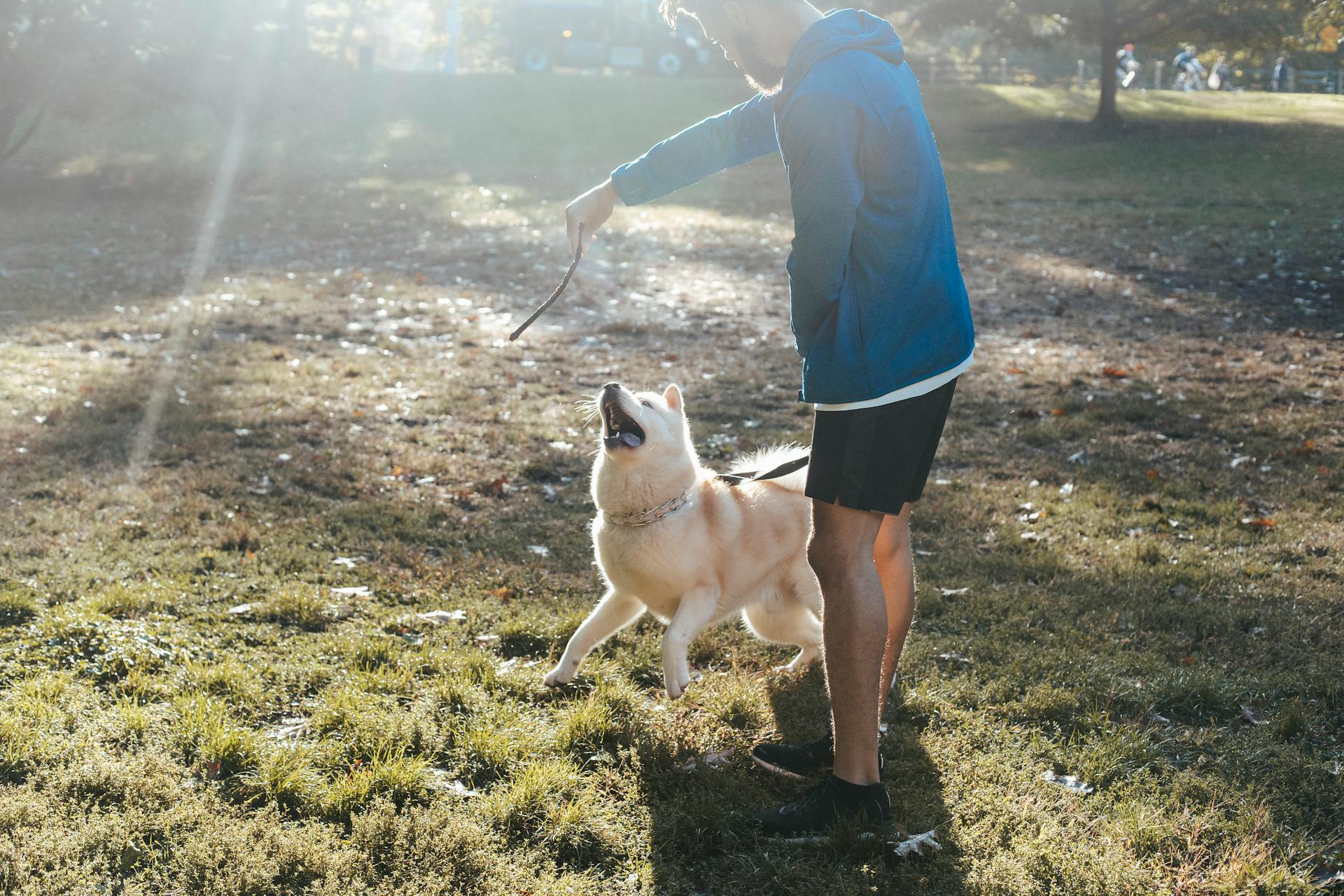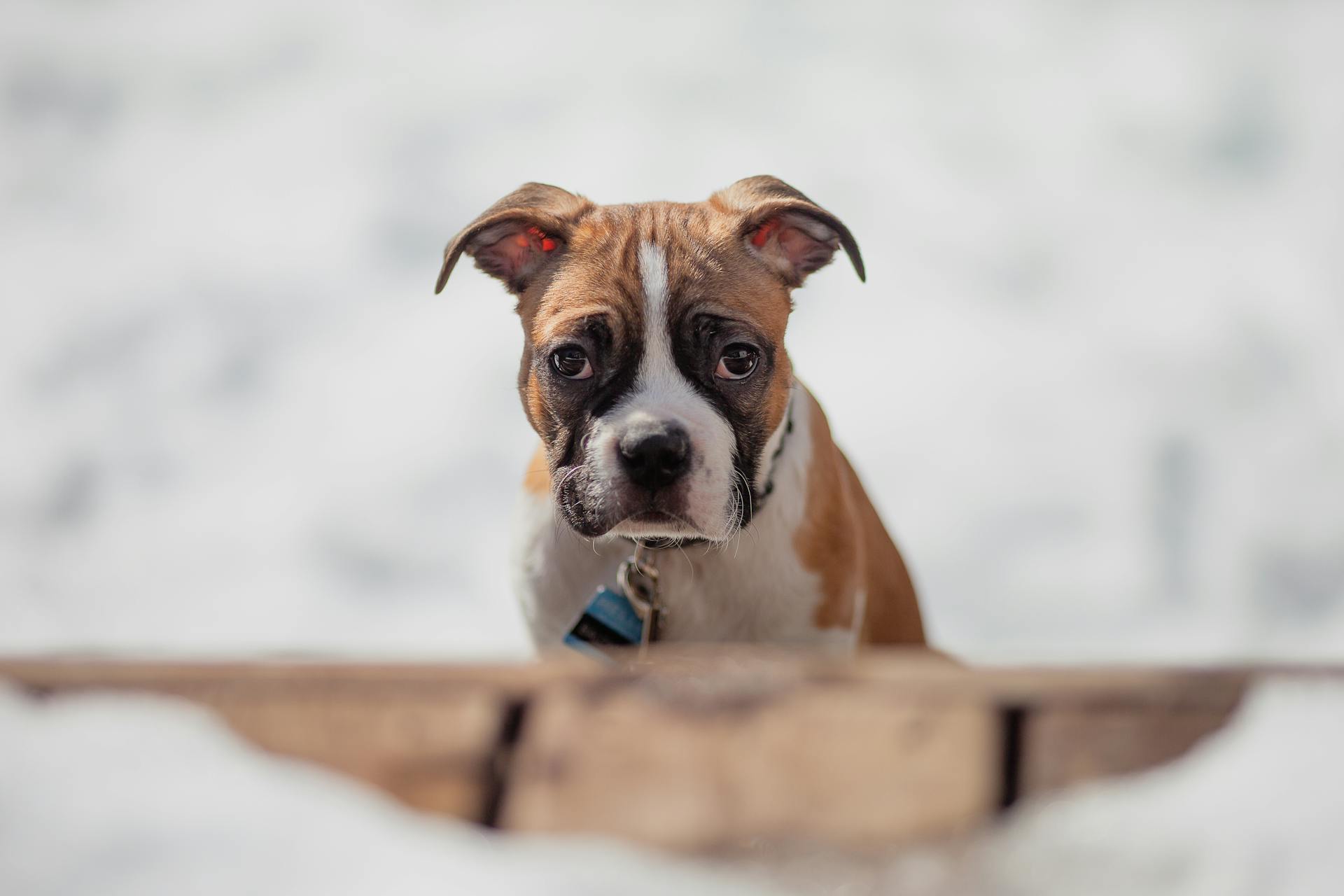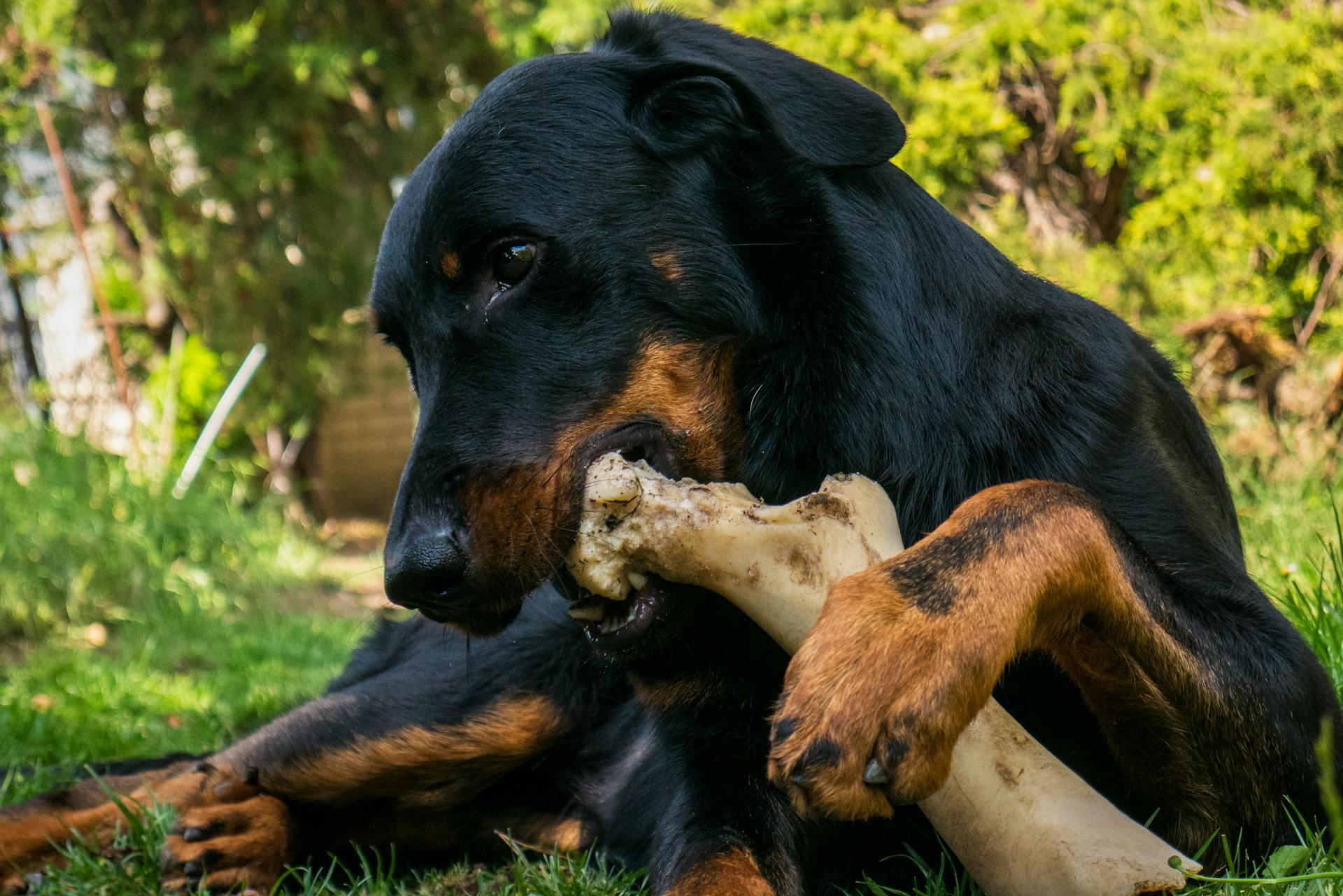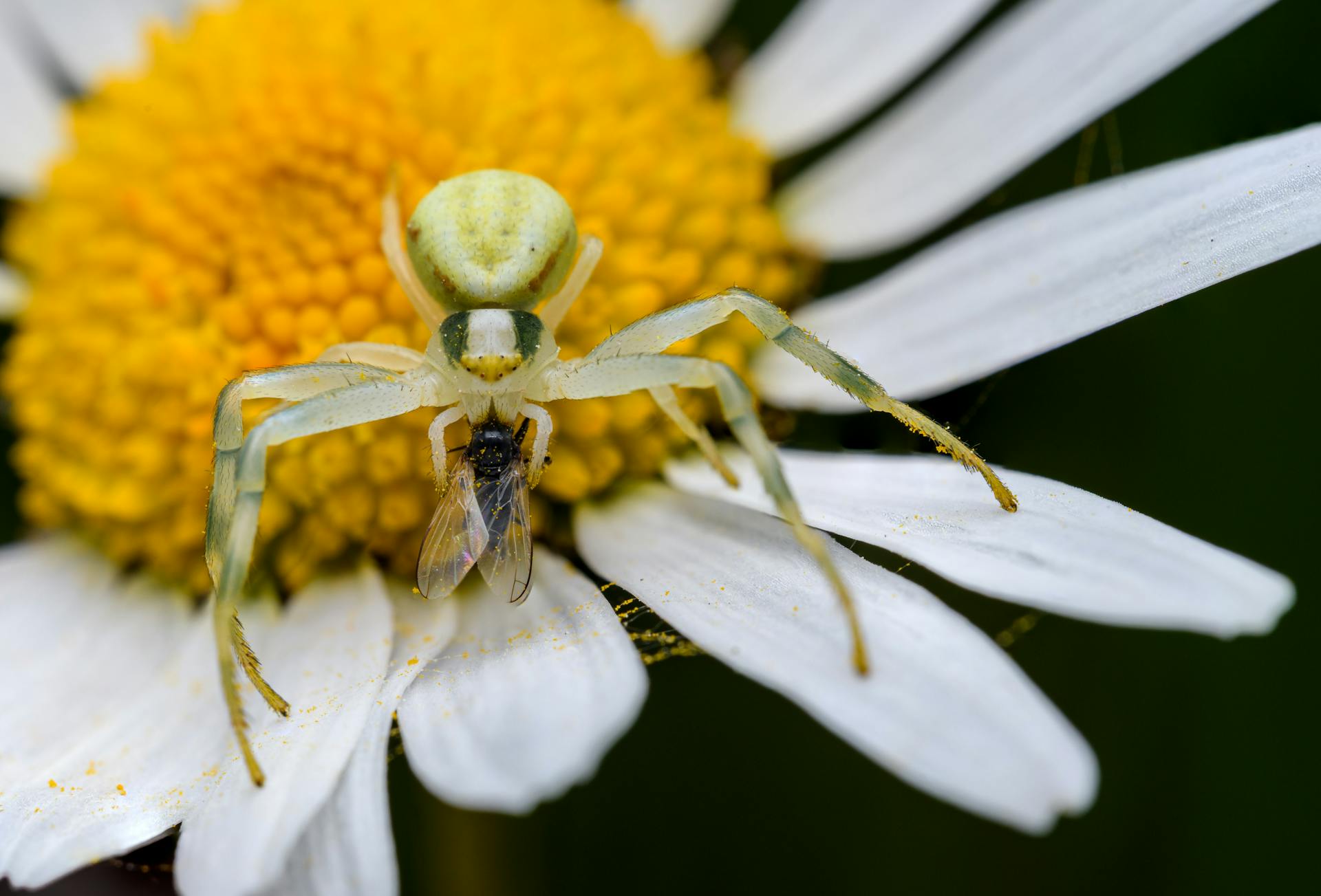
Preventing biting in dogs is crucial for both their safety and your own. According to research, puppies start teething at around 3-4 months old, which can lead to biting behavior.
Biting is a natural behavior for dogs, especially during the teething phase, but it can quickly become a problem if not addressed. Dogs may bite due to teething pain, overstimulation, or to assert dominance.
To prevent biting, it's essential to teach your dog the "gentle" command. This command helps your dog understand that biting is not acceptable behavior. By consistently reinforcing the "gentle" command, you can help your dog develop better impulse control and a more gentle nature.
Some dogs may bite due to resource guarding, which is a common reason for biting in dogs. Resource guarding occurs when a dog feels the need to protect its food, toys, or other resources from others.
Here's an interesting read: Is Resource Guarding Dangerous
Preventing Biting
Start dog training early to prevent biting, as puppy nips may be cute but can easily extend to clothing and furniture as your dog grows. Puppies learn to control their mouths from their mother and siblings, so you can mimic this process by letting out a sharp, high-pitched yelp when they bite, followed by letting your hand go limp.
The ASPCA recommends teaching your pet that biting causes you pain, and you can do this by letting out a yelp and then withdrawing your attention. Repeating this process a few times should be enough to teach your puppy to keep their teeth off your skin.
Bite inhibition is a training method that teaches dogs to bite without exerting pressure, drastically reducing the risk of an extremely harmful bite. All dogs have the potential to bite, so it's essential to train them to prevent dog bites.
To teach bite inhibition, start by teaching your puppy to use their mouth softly. If they nip too hard, say "ouch" in a firm voice, and if they continue to bite hard, you can say "ouch" and then get up and step away from playing for a few minutes.
Here's a scale to help you gauge your puppy's biting:
- 1 – You can feel it, but barely.
- 2 – There's some pressure, but you barely flinch.
- 3 – Wow, those little teeth are sharp, but it's tolerable.
- 4 – Ok, that hurts a bit. It might even leave a mark.
- 5 – Ouch!! That hurts and your hand is now bleeding.
For one week, your puppy gets a time-out if she gives you a level 5 bite. The next week, time out anything that is a 4 or above, and continue this process until your puppy consistently delivers only level 1 bites.
Redirect your puppy's chewing onto acceptable objects by offering her a small puppy-safe chew bone or other type of chew toy whenever you pet her. This will help your puppy learn that people and petting are wonderful and will keep her mouth busy while she's being petted.
Readers also liked: Next Level Dog Training
Teaching Bite Control
Teaching bite control is an essential part of dog training, and it's crucial to start early. All dogs have the potential to bite, and teaching them to bite inhibition can mean the difference between a little nip and a serious injury.
To teach bite inhibition, you can follow the example of a puppy's littermates. If a puppy nips too hard, the others will yelp or stop playing, letting the pup know that the bite was too hard. You can also use a high-pitched "ow!" sound if your puppy bites you, but be aware that this might not work for every puppy.
One effective way to teach bite control is to use a time-out system. For example, if your puppy bites you too hard, stop play and leave her alone for a minute. Each week, ask her to bite a little softer, and time her out for her hardest bites. This will help her learn to moderate the force of her bite.
Explore further: Teaching Dog Obedience
Here's a scale to help you gauge your puppy's bite level:
- 1 – You can feel it, but barely.
- 2 – There’s some pressure, but you barely flinch.
- 3 – Wow, those little teeth are sharp, but it’s tolerable.
- 4 – Ok, that hurts a bit. It might even leave a mark.
- 5 – Ouch!! That hurts and your hand is now bleeding.
Remember, teaching bite control is a process that requires patience, consistency, and positive reinforcement. By following these steps and being mindful of your puppy's behavior, you can help her develop good bite control and reduce the risk of serious injuries.
See what others are reading: Dog Impulse Control Training
Bite Inhibition
Bite inhibition is a crucial training method that teaches dogs to bite without exerting pressure, drastically reducing the risk of an extremely harmful bite. All dogs have the potential to bite, and it's essential to train them to prevent dog bites.
If your puppy grows into an adult and ends up biting someone, you don't want the adult dog to exert a great deal of pressure. Teaching a puppy bite inhibition can mean the difference between a little nip from your dog and a bite that sends the victim to the hospital.
To teach softer bites, you can follow the example of a littermate. Allow your pup to nip a little as long as it doesn't really hurt you, and when your puppy bites a little too hard, say "ouch" in a firm voice.
Recommended read: Crate Training Older Dogs
The first step of teaching bite inhibition is teaching your puppy to use its mouth softly. If your pup was allowed to stay with its litter until it was 8 weeks or older, the puppy's siblings will have already started this lesson.
You can teach your puppy bite inhibition by making a high-pitched "ow!" sound if they bite you. However, be aware that this might get them even more worked up and likely to bite.
Here's a step-by-step guide to teaching your puppy to bite softly:
- Hard bites result in a time-out. Stop play, and leave your puppy alone or put her in a time-out area for about one minute.
- Each week ask your puppy to bite a little softer by timing her out for her hardest bites.
- Don't phase out play biting all together until your puppy is reliably biting softly. Then you can re-direct her to toys or time her out for all bites.
To assess your puppy's bite level, use the following scale:
- 1 – You can feel it, but barely.
- 2 – There's some pressure, but you barely flinch.
- 3 – Wow, those little teeth are sharp, but it's tolerable.
- 4 – Ok, that hurts a bit. It might even leave a mark.
- 5 – Ouch!! That hurts and your hand is now bleeding.
Redirect your puppy's chewing onto acceptable objects by offering her a small puppy-safe chew bone or other type of chew toy whenever you pet her.
If this caught your attention, see: How Long Should a Dog Chew on a Bully Stick
Children and Puppies
Children and puppies can be a volatile combination, especially when it comes to teaching bite control. A child's first reaction to being nipped or mouthed by a puppy is to push the puppy away with their hands and arms, or run and/or squeal and make noise.
This reaction will be interpreted by the puppy as play and will probably cause the puppy to escalate and nip and mouth even more. Never leave a child alone with a puppy, and always monitor closely all interactions between them.
To prevent this, parents should establish clear boundaries and rules for playtime, and consistently enforce them. Ask us for more information about children and dogs.
Broaden your view: Dog Aggression after Neuter
Managing Behavior
Punishing your puppy for biting won't teach them bite inhibition, it'll just make them bite harder.
Make sure all family members are on the same page with the training style to avoid confusing your puppy.
It's essential to work on bite inhibition in different situations and reinforce it daily to ensure your puppy develops good habits.
You can start by teaching your puppy the "leave it" command, which will help them learn to respect personal space and boundaries.
Prevent Learning Delays
Puppies usually learn to control the use of their mouths from their mother and their siblings.

You can mimic this process by letting out a sharp, high-pitched yelp of your own when they bite, followed by letting your hand go limp. This should stop them in their tracks and, if so, praise them for their response.
Repeating this process a few times should be enough to teach them to keep their teeth off your skin.
Dealing with Elevated Behavior
Dealing with Elevated Behavior can be a daunting task, especially when it's linked to biting behavior. Some dogs exhibit elevated behavior due to aggression or fear, which can be challenging to detect.
Mouthing is a normal dog behavior, but in some cases, it can manifest as a result of aggression or fear. Problem biting is often characterized by rapid biting followed by a quick retreat.
A tense face and rigid body posture are warning signs of a serious problem. If you notice these signs in your dog, it's essential to seek professional help.
Attempting to deal with biting behavior yourself can lead to injury and serious behavioral damage to your dog. It's crucial to contact a certified dog training professional, like those at Innovative K9 Academy, who understand the challenges associated with biting behavior.
Additional reading: Dog Fear Aggression
Behavior and Proofing
Behavior and proofing are crucial aspects of managing your puppy's behavior. Punishing your puppy for biting won't teach them bite inhibition, so it's essential to focus on positive reinforcement instead.
A common mistake people make is trying to suppress biting by punishing the puppy, but this approach can backfire. If you punish your puppy for biting, they may become more likely to bite hard in the future.
To work on bite inhibition, you need to be consistent and reinforce gentle biting in different situations. This means practicing with your puppy daily to ensure they understand what's expected of them.
One way to start cutting back on biting is to teach your puppy the "leave it" command. This command is essential in helping your puppy learn to respect boundaries and not use their mouth without being invited to play.
Teaching the "leave it" command involves holding treats in your hand and giving the command, then rewarding your puppy for backing off. It's essential to act quickly and reward your puppy for calm behavior, as this will help them associate the command with positive outcomes.
A different take: Leave It Dog Training
Puppies learn through reinforcement and consistent messages, so it's crucial to be patient and consistent when training. If you're not, your puppy may become confused and resistant to training.
Here are some things to avoid when trying to manage your puppy's biting behavior:
- Don't tap or hold your puppy's mouth closed for nipping
- Avoid squeezing their paws when they jump
- These approaches can lead to negative consequences, such as hand-shyness, fear, or defensive behavior.
By following these tips and being consistent, you can help your puppy develop good biting behavior and avoid common pitfalls.
Never as an Acceptable Option
Biting is never an acceptable option for dogs. This rule is non-negotiable.
Your dog uses his mouth to explore the world, but that doesn't mean humans are fair game. Dogs bite primarily out of aggression, frustration, possessiveness, or the drive for prey.
Unless you use evidence-based dog training techniques, your dog can develop behavioral patterns that pose a bite risk. This is why it's essential to establish acceptable behavior from an early age.
Puppies usually learn to control their mouths from their mother and siblings, so you can mimic this process by letting out a sharp, high-pitched yelp when they bite, followed by letting your hand go limp. This should stop them in their tracks and teach them to keep their teeth off your skin.
Your dog's teeth will strengthen and grow as they mature, making it crucial to teach them to control their biting early on. Puppies nip may be cute and harmless, but they can quickly escalate to damaging your belongings and causing harm to humans.
Quiet Time or Potty Break
Sometimes a biting puppy is really an over-tired puppy, and they need to be put in a quiet space or crate to take a nap.
Puppies get over-tired when they don't get enough sleep or have too many stimulating activities in one day.
Offering a quiet time or potty break can be a lifesaver for both you and your puppy.
Sources
- https://www.siriuspup.com/behavior-problems/puppy-biting
- https://innovativek9academy.com/news/dog-training-challenges-how-to-stop-biting
- https://www.thesprucepets.com/bite-inhibition-training-for-puppies-1118223
- https://www.akc.org/expert-advice/training/stop-puppy-biting/
- https://www.oregonhumane.org/portland-training/teaching-bite-inhibition-and-dealing-with-rough-puppy-play/
Featured Images: pexels.com


